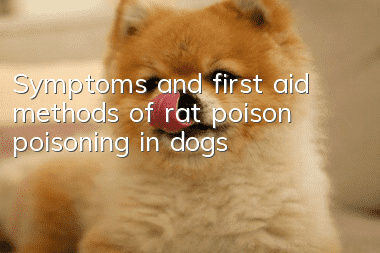Symptoms and first aid methods of rat poison poisoning in dogs

Rat poison can be divided into 6 categories according to its properties: anticoagulant rat poison, inorganic phosphorus rat poison, organophosphorus rat poison, organofluorine rat poison, cyanide melt rat poison and other rat poisons. Since there are 6 categories of rat poison, the symptoms are slightly different.
1. Warfarin poisoning (dicoumarol) poisoning: such as raticide, rat enemy.
Symptoms: Anticoagulant rodenticides are the most common and cause chronic poisoning. Bleeding is the most common symptom, but there is often an incubation period of 2 to 5 days before this symptom appears. The main symptoms are extreme depression, elevated body temperature, loss of appetite, anemia, weakness, internal and external bleeding, and external bleeding including nosebleeds, vomiting, and hematuria. , bloody stool or black stool. When internal bleeding occurs in the chest and abdomen, difficulty breathing occurs; when it occurs in the brain and spine, neurological symptoms occur; when it occurs in joints, claudication occurs. Intra-articular bleeding, subcutaneous and submucosal bleeding can also be seen. Subcutaneous bleeding can cause dermatitis and skin inflammation. Necrosis, severe bleeding from nostrils, rectum and other natural orifices, large amounts of poisoning, typical bleeding symptoms and death in the stomach. Chronic poisoning can manifest as anemia, edema, heart failure, and in the final stage, spasm and paralysis. Jaundice may occur when the disease lasts for a long time.
Treatment: induce vomiting and replenish blood in acute poisoning and supplement vitamin K; for sub-acute poisoning, subcutaneously inject vitamin K until the coagulation time is normal, then switch to oral vitamin K1, 15 to 30 mg, twice a day for 4 to 6 days. In severe cases, fresh whole blood needs to be transfused at 10-20ml/kg of body weight, quickly in the first half and 20 drops/minute in the second half. Warfarin and rat poisoning sometimes takes one month, and barbiturate sedation or light anesthesia is used as an auxiliary treatment. Note: To be on the safe side, as long as this type of poisoning is suspected, vitamin K1 should be taken orally immediately.
2. Poisoning by organophosphorus compound pesticides: such as trichlorfon, dimethoate, dichlorvos, trithion, malathion, etc.
Symptoms: At first, there is excitement and restlessness, muscle spasms, ranging from tremors to twitching. When the muscles of the limbs are clonic, the sick dog steps frequently and swims when lying down. The pupils are constricted and may become linear in severe cases. Excessive salivation, tearing, abdominal pain, loud bowel sounds, constant diarrhea, and even fecal incontinence. In the later stages of severe illness, bowel sounds weaken or even disappear. Sweat dripping all over the body, especially around the chest, perineum and scrotum. The body temperature increased, breathing was obviously difficult, the heartbeat was rapid, the pulse was weak, the conjunctiva became cyanotic, and finally he died of suffocation. When the poisoning dose is relatively mild, bleeding may occur 12 to 24 hours later.
Treatment: Slow intravenous injection of atropine sulfate at a dosage of 0.05 mg/kg body weight. After an interval of 6 hours, atropine sulfate was injected subcutaneously or intramuscularly at a dosage of 0.15 mg/kg body weight. When the dog has dry mouth, dilated pupils, stable breathing, and rapid heartbeat, the medication can be stopped. Be strictIn severe cases, it is best to use atropine in combination with pralidoxime iodide and pralidoxime chloride. Pralidoxime iodide (Pam) and pralidoxime chloride (pralidoxime chloride) are cholinesterase reactivators, but they have poor efficacy against the pesticide poisoning mentioned above and must be used together with atropine. The dosage of pralidoxime iodide is 20 mg/kg body weight each time, intravenously, and repeated administration once every 12 hours if necessary. The dosage of pralidoxime chloride is 20 mg/kg body weight each time. Bisphosphonate passes through the blood-brain barrier and acts similarly to atropine. The dosage is 15 to 30 mg/kg of body weight each time. However, some dogs are allergic to pralidoxime iodide and pralidoxime chloride, so attention should be paid. In addition, diphenhydramine can also be taken, 1 to 4 mg/kg, orally, 3 times a day, mainly for cases of muscle spasm and tremor.
3. Organofluorine poisoning
Symptoms: Dogs drink water contaminated by organic fluorine compounds or eat rats poisoned by fluoroacetamide, causing central nervous system excitement. Restlessness, vomiting, dyspnea, arrhythmia, increased defecation frequency, running and screaming, paroxysmal or tonic muscle spasms, foaming at the mouth, and finally coma and wheezing, and death due to respiratory depression and heart failure during convulsions.
Treatment: Acetamide (acetamide) can prolong the incubation period of poisoning and reduce the symptoms. Dosage: 0.1 mg/kg body weight each time. The first dosage is half of the whole day's dosage, and the remaining half is divided into 4 parts and injected every 2 hours. Medication must be taken early and the dose must be sufficient. If used in conjunction with chlorpromazine and barbiturate sedatives, the excitability of the central nervous system can be reduced. It can be combined with inducing vomiting and gastric lavage to allow sick dogs to eat raw egg white to protect the mucosa of the digestive tract. Intravenous injection of 5 to 10 ml of calcium gluconate is also beneficial.
4. Rodenticide poisoning
Symptoms: Accidental ingestion of this white, odorless crystalline powder causes the permeability of pulmonary capillaries to increase, causing a large amount of plasma to enter the lung tissue, leading to pulmonary edema. The sick dog vomited and foamed at the mouth, followed by diarrhea, coughing, difficulty breathing, depression, cyanosis of the mucous membrane, and frothy bloody mucus flowing from the nostrils. Due to difficulty in breathing, dogs often sit in a sitting position, have a weak pulse rate and low temperature. After 12 hours, they may die due to lack of oxygen. There is no specific antidote for this medicine. Methods of inducing vomiting, gastric lavage, catharsis, rehydration, and diuresis can be used.
5. Poisoning by chlorinated hydrocarbon pesticides, such as diditidine, 666, TDE, chlordan-endosulfan and other pesticides
Symptoms: Extreme excitement, mania, tremors in the head and neck first, then spreading to the whole body, salivation, not eating or eating less, and diarrhea. In severe cases, the mucous membranes become red, restless, and paroxysmal body spasms occur from time to time, with white foam at the corners of the mouth. Hypersensitivity to hearing and touch may occur. If the poison is taken orally, vomiting may occur and the body temperature may rise. Once the person falls to the ground, the limbs will scratch randomly and show opisthotonus, which is the difference from other poisonings.
Treatment: Cleansing and gastric lavage can be used, and then salt laxatives can be used for catharsis. Hyperexcitability in dogs can be treated symptomatically by administering sedatives. Since the dog is dehydrated and not eating, intravenous fluids should be given.Those who are poisoned through the skin should wash the local area with plenty of warm soapy water, and those who are poisoned through the mouth should be fed activated carbon and artificial salt. Do not induce vomiting! It will cause muscle spasm. To control excessive excitement, diazepam and pentobarbital are commonly used. However, if there is no convulsion, pentobarbital cannot be used and only diazepam can be used.
6. Zinc phosphide rodenticide poisoning, commonly used rodenticide in gray powder form
Symptoms: Symptoms usually appear within 15 minutes to 4 hours, causing abdominal pain, inability to eat, vomiting, coma and drowsiness, suffocation, diarrhea, and bloody stools. The vomitus contains black blood, phosphorescence can be seen in the dark, and has the smell of acetylene. Movement disorders, barking, increased body temperature and acidosis, and finally struggling in the limbs, hyperesthesia, until muscle spasms, leading to death due to lack of oxygen.
Treatment: 10 to 30 ml of 0.2% to 0.5% copper sulfate solution can be administered to induce vomiting. Gastric lavage can be performed with 0.02% potassium permanganate solution, followed by 15 grams of sodium sulfate for catharsis. Intravenous injection of hypertonic glucose solution protects the liver. Gastric lavage with 5% sodium bicarbonate can also be used in the early stage, and 5% sodium bicarbonate can be taken orally to increase the gastric pH and prevent the release of zinc phosphide. Fast for 24 hours to reduce gastric acid secretion.
7. Poisoning by carbamate esters, such as fenacetate, methotrexate, carbaryl, carbofuran, synoxur, methoxy, etc.
Symptoms: Similar to organophosphorus poisoning, but its duration is shorter
Treatment: Basically the same as organophosphorus treatment, atropine sulfate should be injected as soon as possible, and the drug can be repeated if necessary
8. Arsenic poisoning
Symptoms: Severe abdominal pain, muscle tremors, salivation, vomiting, staggering steps, diarrhea, thirst, hind limb paralysis, swelling of the oral mucosa, and the gums turn dark black. In severe cases, oral mucosa can ulcerate and fall off. Some dogs are in a state of excitement, twitching, sweating, having cold body extremities, and some muscles are paralyzed. Prolapse of the penis can be seen in male dogs.
Treatment: 1 to 2 ml of 10% dithiopropanol is commonly used, intramuscularly injected once every 1 to 2 hours, and used 3 to 4 times. 50 to 80 ml of 5% sodium thiosulfate solution can also be injected intravenously.
9. Food Poisoning
Symptoms: Bacteria in spoiled food, such as Staphylococcus, Salmonella, Clostridium botulinum, etc., can cause symptoms of severe vomiting, abdominal pain, diarrhea and acute gastroenteritis. The sick dog is depressed, has heart failure, and has a normal or slightly lower body temperature. Severe poisoning can cause convulsions, restlessness, difficulty breathing and severe convulsions.
Treatment: If the dog is poisoned after eating rotten fish, the incubation period does not exceed 2 hours. The dog suddenly vomits, has diarrhea, difficulty breathing, excessive nasal discharge, dilated pupils, ataxia, possible coma, hindquarters paralysis, weakness, hematuria, and black feces. Glucose, vitamin C, oral diphenhydramine can be injected intravenously or subcutaneously, and penicillin can be injected intramuscularly or subcutaneously. For staphylococcal poisoning, the emetic agent apomorphine can be injected intravenously in the early stage.The amount is 0.04 mg/kg body weight. Gastric lavage, fluid rehydration and symptomatic treatment if necessary. At the same time, perform hunger therapy and stop feeding. For poisoning caused by Clostridium botulinum toxin, antitoxin serum should be injected intravenously or intramuscularly immediately, gastric lavage with 0.01% potassium permanganate solution, laxatives or enema, intravenous infusion, and intramuscular injection of penicillin can be used.
10. Phenol poisoning is widely used in public health disinfection. Common ones include carbolic acid, lysol, guaiacol, and xylene
Symptoms: Damage to the nervous system, redness and oozing of skin in contact. Causes listlessness, vomiting, tonic spasms, and paralysis.
Treatment: For poisoning due to skin contact with phenol preparations, wash the local skin with water, then rinse with 10% ethanol, and then wrap the affected area with an oil-soaked dressing. If poisoned by accidental ingestion of phenol preparations, gastric lavage, oral administration of milk, egg greens or activated charcoal, intravenous diuretics, and intramuscular injection of isoproterenol can be performed.
11. Strychnine poisoning is usually dyed red, purple or green when used as rodenticide
Symptoms: Appear within 10 minutes to 1 hour of ingestion. The earliest symptoms include fear, hypersensitivity, muscle stiffness, and abdominal and neck muscle stiffness. When the most obvious fear of light, sound, touch and other irritating factors are present, there may be strong epileptic seizures, similar to tetanus, with no trauma to the body surface, and the degree of spasm of high-fiving the hands is aggravated.
Treatment: When there is no spasm or hyperesthesia, vomiting can be induced, gastric lavage, sedatives can be used, tracheal intubation can be used to deliver oxygen, and artificial respiration can be implemented if necessary.
12. Cholecalciferol poisoning, granular poison bait
Symptoms: Symptoms appear within 24 hours after ingestion, including vomiting, anorexia, polyuria, polydipsia, and hypercalcemia.
Measures: Induce vomiting as soon as possible after ingestion, and administer 1g/ml activated carbon. After that, use sodium sulfate to treat hypercalcemia. Blood calcium should be continuously tested 24, 48, and 96 hours after ingesting the poison. Within a week after poisoning, avoid direct sunlight and feed low-calcium dog food.
13. Poisoning by arsenic and nifendiurea, the trade name is Rodent Killer, which is a powder
Symptoms: vomiting, abdominal pain, muscle tremors, general weakness, diabetes and blindness later, coma within 12 to 24 hours, and respiratory and cardiac failure.
Measures: induce vomiting in the early stage, gastric lavage, intramuscular injection of nicotinamide 500-1000 mg, and intramuscular injection of 200-300 mg every 4 hours for the next 48 hours, and oral administration of nicotinamide 200 mg three times a day within 2 weeks. After surviving, you should have regular urine tests to detect diabetes as early as possible.
Recommended Good Things
Aineng Pet Odor Disinfectant, effectively removes body odor/feces odorWait for the smelly molecules! Effective in treating skin diseases caused by fungi/bacteria! Can kill parvovirus/canine distemper virus/coronavirusetc!
It is edible grade for pets, does not contain fragrances, does not contain chemicals, can be sprayed directly, and is harmless to human pets!
Consultation: 13028809308 (WeChat synchronization)
Scan the QR code on WeChat to enter the purchase
- What medicine should be used for dogs taking medicated baths?
- Causes of stillbirth in dogs
- Precautions for daily feeding of dogs
- Is it okay to neuter a male Teddy dog?
- How does a pet dog survive the dangerous period when it first arrives in a new home?
- How old can an Akita dog be to train? What should you pay attention to when training Akita dogs?
- Foreign golden retriever toilet training method
- Things that novices should pay attention to when choosing golden retriever puppies at the kennel (dog farm)
- Are dogs with different eyes precious?
- How long does it take for a dog to lose fetal hair?



